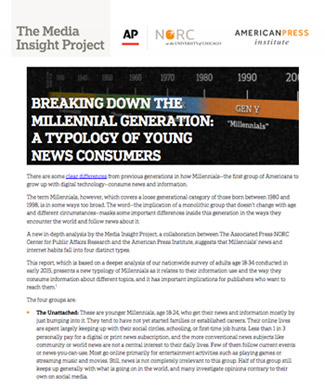 Let the niching of millennials begin.
Let the niching of millennials begin.
How to communicate with millennials—the 80-million-strong generation of people born between early 1980s and 2000—is taking up more and more bandwidth among both brands and organizations.
But when it comes to how they consume and share news and information, millennials can be an elusive bunch.
Now companies have a road map for how to cater more effectively to millennials, thanks to a new study saying that millennials’ news and Web habits fall into four distinct types.
Media Insight Project—a collaboration between The Associated Press-NORC Center for Public Affairs Research and the American Press Institute—took the pulse of 1,045 adults between the ages of 18 and 34 was conducted earlier this year. The final response rate was 14 percent
The four groups in the study are:
• The Unattached: These are younger millennials, age 18-24, who get their news and information mostly by just bumping into it. They tend to have not yet started families or established careers. Their online lives are spent largely keeping up with their social circles, schooling, or first-time job hunts. Less than 1 in 3 personally pay for a digital or print news subscription, and the more conventional news subjects like community or world news are not a central interest to their daily lives.
• The Explorers: These are younger millennials, also age 18-24, who actively seek out news and information. These millennials are relatively similar demographically to the Unattached (i.e., they have not yet developed families or careers), but this group consists of slightly more men than women. They are highly connected (97 percent have smartphones), and they are interested in news and are more active in pursuing it online.
• The Distracted: These are older millennials, age 25-34, who have begun to have families and are part of the middle class. They tend not to use news or information for civic or social purposes. They mostly bump into news and information rather than actively seek it out, and a majority of them do not personally pay for a news subscription.
• The Activists: This is another group of mostly older millennials, age 25-34, but Activists, unlike the Distracted, are more likely to actively seek out news and information. These millennials tend to have already established families, careers, and a connection to their community. They are racially and ethnically diverse—the only group that is a majority non-white. They have acquired enough experience in the world to care about certain issues, and enough stability in life to spend energy on those issues.

The study makes a strong case that millennials are not monolithic with regard to their news habits, and a one-size-fits-all strategy may prove counterproductive.
For example, while a majority of Explorers (85 percent) regularly go online and keep up with what’s going on in the world, just a little more than half of Distracted do so. What is more, 74 percent of Explorers said they are more likely to use news to talk with others about what’s going on, but less than half of Distracted share news with others.
Explorers also are more likely to use the Web and social media to gather information and connect with people. A majority, for instance, said they get news at least several times a day from Facebook (52 percent).
Explorers also are among the most likely to get news at least several times a day from Reddit (12 percent), Twitter (14 percent), Instagram (25 percent), and YouTube (29 percent).
Many Explorers also report using Facebook to get more information on something they heard about in the news (39 percent), the study said.
That is higher than any other group, including Activists, the most news-oriented older millennials (24 percent of whom do this kind of deep diving of news on Facebook), the Unattached (28 percent), or the older Distracted (31 percent).


 Abandon traditional content plans focused on a linear buyer progression and instead embrace a consumer journey where no matter which direction they travel, they get what they need, stressed marketing pro Ashley Faus during O'Dwyer's webinar Apr. 2.
Abandon traditional content plans focused on a linear buyer progression and instead embrace a consumer journey where no matter which direction they travel, they get what they need, stressed marketing pro Ashley Faus during O'Dwyer's webinar Apr. 2. Freelance marketers and the companies that hire them are both satisfied with the current work arrangements they have and anticipate the volume of freelance opportunities to increase in the future, according to new data on the growing freelance marketing economy.
Freelance marketers and the companies that hire them are both satisfied with the current work arrangements they have and anticipate the volume of freelance opportunities to increase in the future, according to new data on the growing freelance marketing economy. Home Depot's new attempt to occupy two market positions at once will require careful positioning strategy and execution to make it work.
Home Depot's new attempt to occupy two market positions at once will require careful positioning strategy and execution to make it work. Verizon snags Peloton Interactive chief marketing officer Leslie Berland as its new CMO, effective Jan. 9. Berland succeeds Diego Scotti, who left Verizon earlier this year.
Verizon snags Peloton Interactive chief marketing officer Leslie Berland as its new CMO, effective Jan. 9. Berland succeeds Diego Scotti, who left Verizon earlier this year.  Norm de Greve, who has been CMO at CVS Health since 2015, is taking the top marketing job at General Motors, effective July 31.
Norm de Greve, who has been CMO at CVS Health since 2015, is taking the top marketing job at General Motors, effective July 31.


 Have a comment? Send it to
Have a comment? Send it to 
No comments have been submitted for this story yet.